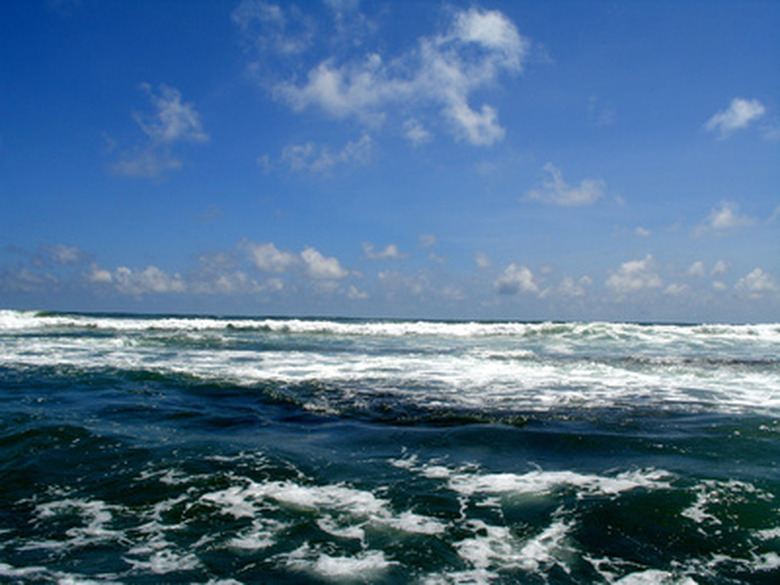Types Of Plants In The Indian Ocean
The Indian Ocean is the third-largest component of the so-called World Ocean (as all of Earth's subcategorized oceans are connected), lying between the Atlantic and Pacific and framed by Africa, Asia, Australia and Antarctica. The great majority of the ocean lies south of the Equator, and major islands are relatively few. Its average depth of 12,600 feet is less than that of the Pacific, more than that of the Atlantic. The Indian Ocean provides habitat for a great variety of organisms, including aquatic plants and plant-like creatures.
Seagrasses
Seagrasses
Various species of seagrasses are some of the most significant species of true plants in the Indian Ocean. They often grow in areas relatively sheltered from rough seas, like estuaries and bays. The major hot spot for seagrass diversity is the waters off western Australia — with shores against the Timor Sea, Indian Ocean and Southern Ocean — where 26 species have been described. The Wooramel Seagrass Bank, a submerged platform on the eastern edge of western Australia's Shark Bay, boasts a seagrass bed spanning over 1,500 square miles, the biggest single bed in the world.
Ecological Importance
Ecological Importance
Seagrass beds serve critical ecological functions, and surveyed locations often reveal substantial biodiversity. The Australian Heritage Database notes the vital habitat provided by the Wooramel Seagrass Bank. Various marine organisms, including fish and crustaceans, use the bank as a nursery ground, for example — a role seagrasses provide around the world. The imperiled dugong, a species of plant-eating marine mammal, seems to rely heavily on the Wooramel seagrasses in this part of the world; indeed, the Australian Heritage Databasae suggests the bank "could be crucial to the survival of the region's dugong population."
Phytoplankton
Phytoplankton
As in other seas and oceans, much of the Indian Ocean's marine ecosystem hinges on the existence of phytoplankton, a diverse suite of microscopic organisms that includes tiny plants. Phytoplankton are responsible for half of the world's photosynthesis operations accomplished by plants, so they provide much of the oxygen critical to many organisms' survival. They also serve as the base for the underwater food chain: The tiny animals called zooplankton feast on phytoplankton, themselves supporting fish, squid and other creatures — and on up the rungs and pathways of the food web. A 2005 news report by NASA's Earth Observatory summarized global phytoplankton population trends, with increases seen along coasts and decreases in mid-ocean "gyres" (blocks of spiraling current), including in the north-central Indian Ocean.
Algae
Algae
Algae are simple, plant-like organisms that, like plants, produce energy through photosynthesis. They are a component of the ocean's plankton swarms. In the Indian Ocean, they also exist in other forms. Many kinds of corals exist in symbiotic, or mutually beneficial, relationship with certain species of photosynthetic algae that produce energy the corals can use. A 2010 study funded by Penn State University, the World Bank, Florida International University and the National Science Foundation revealed significant diversity of symbiotic coral-algae associations in the Andaman Sea, a northeastern arm of the Indian Ocean.
References
- "Oceanography"; M. Grant Goss; 1995
- "Seagrasses of Western Australia"; Mike van Keulen; October 2005
- Australian Heritage Database: Wooramel Seagrass Bank
- "Dictionary of Nature"; David Burnie; 1994
Cite This Article
MLA
Shaw, Ethan. "Types Of Plants In The Indian Ocean" sciencing.com, https://www.sciencing.com/types-plants-indian-ocean-7472913/. 22 November 2019.
APA
Shaw, Ethan. (2019, November 22). Types Of Plants In The Indian Ocean. sciencing.com. Retrieved from https://www.sciencing.com/types-plants-indian-ocean-7472913/
Chicago
Shaw, Ethan. Types Of Plants In The Indian Ocean last modified March 24, 2022. https://www.sciencing.com/types-plants-indian-ocean-7472913/
